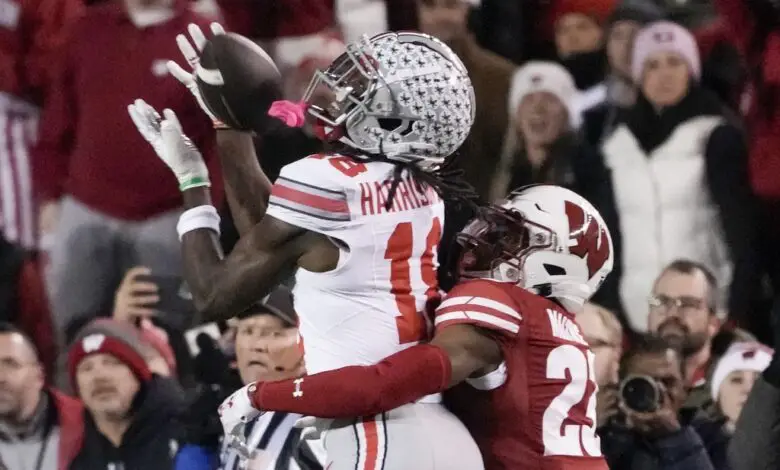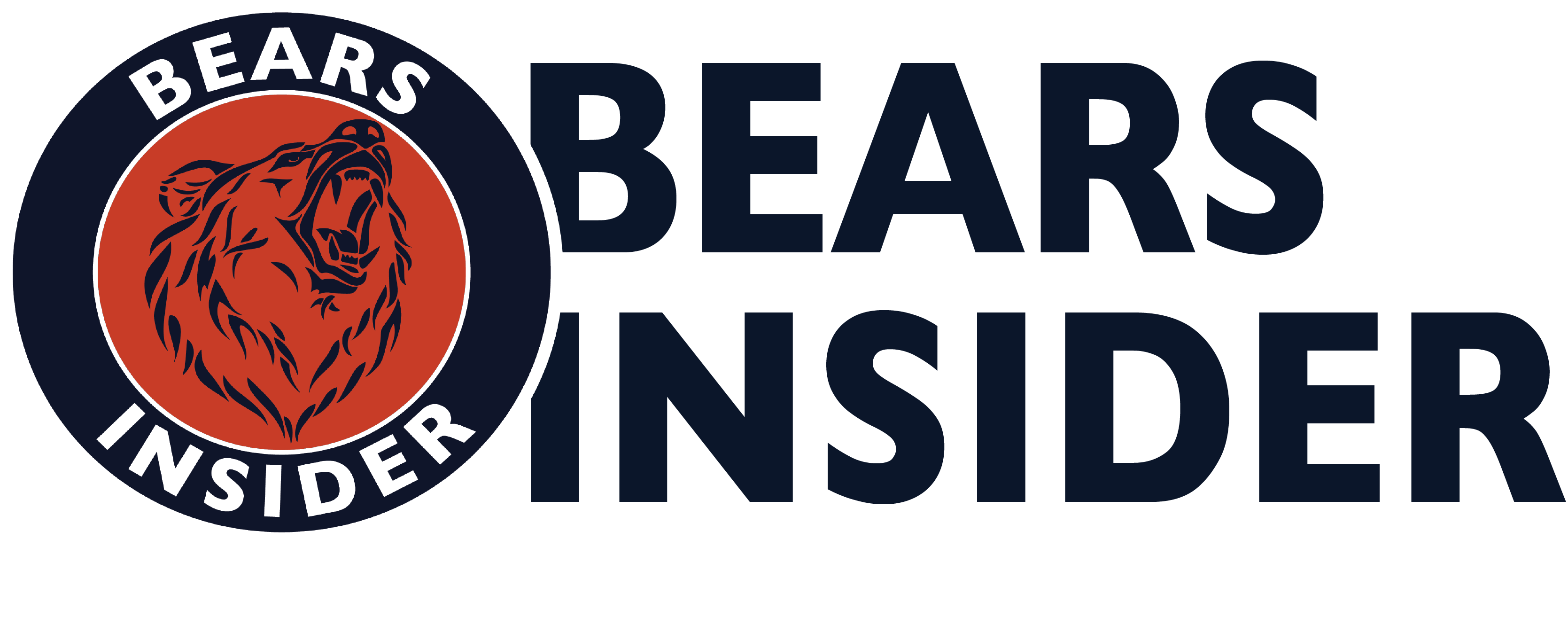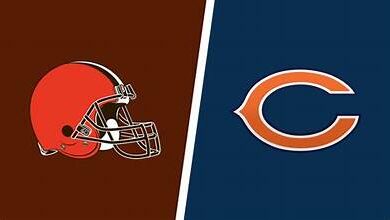
2024 NFL Draft Rankings: Wide Receivers
The NFL Draft begins on Thursday, April 25th, and as I mentioned in my edge rankings piece, many believe the Bears should select a wide receiver with the ninth pick. The Bears brought in Shane Waldron as the offensive coordinator, and he loves attacking defenses with explosive plays. Another weapon for the quarterback could only help create those plays. The 2024 draft class has many talented wide receivers, and there are plenty of playmakers whether the Bears address the position in the first round or later. Here are my rankings for the 2024 wide receiver draft class.
The Bears have come a long way since Ryan Poles arrived in 2022, and the wide receiver position may be the biggest beneficiary. Darnell Mooney was the number-one wide receiver in 2022, but he’s not on the team this year after being signed by the Atlanta Falcons. The Bears are hoping for an encore performance from D.J. Moore this year, and they’ve added veteran wide receiver Keenan Allen. 2022 draft pick Velus Jones Jr and resigned veteran Dante Pettis are the only receivers still on the roster from the 2022 season. 2023 draft pick Tyler Scott had some ups and downs last year, but he looks to make a sophomore season jump and make an impact as the front runner for the third wide receiver spot. However, a new addition from the draft could threaten Scott’s plans.
The #Bears will divide their front office into different teams in the coming weeks. Each will argue they should draft either a receiver, left tackle or edge rusher at No. 9 overall. All will have good points.https://t.co/3RMr1UI1TZ
— Patrick Finley (@patrickfinley) March 28, 2024
- Marvin Harrison Jr. Ohio State 6’3″ 209lbs
Marvin Harrison Jr. spent most of his junior year with announcers and analysts talking highly about his talent, and he didn’t disappoint. He replicated his success from 2022 but did it in one less game this time. Harrison uses all the tools you would expect from an NFL wide receiver, and as a second-generation star, he is already doing it at a high level. He’s most dangerous because of his route-running ability. Harrison utilizes jab steps and can stop on a dime, but the way he fluctuates his speed might be the most impressive. He does almost everything right, but I have concerns about his run-after-catch ability. Harrison rarely broke tackles, and he didn’t show any elite elusiveness. Still, he’ll be a perennial Pro Bowl talent if he stays healthy, and teams would be crazy not to make him a top-five selection this year.
2. Malik Nabers LSU 6’0″ 200lbs
Malik Nabers is the subject of many WR1 talks lately, but it’s the season of lying, and I believe there’s more smoke than fire. However, if a team took Nabers ahead of Harrison, it wouldn’t be fruitless. Nabers is smaller, but he’s very well-rounded. He’s one of the best route runners and has fluid movement, maintaining speed through his cuts. Nabers is a dangerous vertical threat running away from the defender, tracking the ball, and getting under it for the catch, or he can highpoint the ball and snag it. He didn’t have a diverse route tree at LSU, but Nabers excelled in the routes he ran. He caught with his arms instead of his hands too often, making me concerned that he’s not as reliable a pass-catcher as I initially thought. I had hoped the combine would alleviate those concerns, but Nabers didn’t participate much, so we wait and see.
3. Keon Coleman FSU 6’3″ 213lbs
I know what you’re thinking, and no, this isn’t a typo. There’s more to being an excellent receiver than top-end speed. Keon Coleman isn’t the fastest prospect, but he’s a fantastic route runner with phenomenal body control and top-tier hands. Coleman has the length to snag balls and the strength to catch through contact. He’s also very intelligent after the catch and uses smart angles and vision to compensate for his lack of speed. Coleman is more quick than fast, and he needs to work on his initial burst if he’s going to quiet the talks surrounding his 4.61 40-yard-dash time. After the catch, Coleman is elusive and strong, and he won’t go down without a fight. Coleman is equipped with a juke, hurdle, and stiff arm and deploys them precisely to gain extra yards. You must get defenders on their heels in the NFL, and Coleman can do that.
Keon Coleman is #good pic.twitter.com/VdAT9MYIKc
— Nick Penticoff (@NickPenticoff) March 24, 2024
4. Rome Odunze Washington 6’3″ 212lbs
Rome Odunze doesn’t consistently lose defenders, but does he need to? He caught 21 of his 28 contested catches and showed he knows how to use his body to box out defenders. I dropped Odunze to the fourth spot because he needs tools to get defenders on their heels. He runs smooth routes and maintains speed throughout, but defensive backs are faster and smarter in the NFL. They won’t let receivers win with just speed. NFL defenders will get more physical with Odunze, and he struggled in college against physical press coverage. If Odunze develops a way to overcome physical defenders, he will have a successful career. His body control and flexibility allow him to stay fast and contort in the air with a large catch radius. Odunze is stronger than he looks, too, and he will consistently find extra yards falling forward. He won’t wait long, April 25th.
5. Troy Franklin Oregon 6’2″ 176lbs
I wish Troy Franklin was 20 pounds heavier because most of his holes seem to be mendable with more muscle and strength. Franklin could be a better blocker and lacks aggression at the contact point. He must also get more aggressive through contact against press physicality at the line or contact at the top of his route. Lastly, Franklin is only okay in contested catch situations, and contact overwhelms him too much. That said, Franklin is a quick player and one of the top vertical threats in the draft. He uses savvy moves to beat defenders off the line and keeps corners guessing by maintaining variety. Despite his slighter frame and lower weight, he maintains balance through contact, and tackling him can quickly become challenging. Franklin is an exciting prospect, and I look forward to his future in the NFL.
6. Xavier Legette South Carolina 6’1″ 221lbs
Xavier Legette was the player who made me most excited for this wide receiver class. Legette is a little shorter, but what he lacks in height, he makes up for in leaping ability. With a 40-inch vertical, Legette will be a consistent difference maker, and at 221 pounds, he will avoid most of Franklin’s shortcomings. Legette is agile and has the balance to be a consistent YAC threat, but his angle choices and vision need some fine-tuning. He ran a 4.39 40 but took too long to get to his top speed in games. Legette also needs to throttle his speed more to catch defenders off guard and be able to work back to the ball, which he didn’t do enough. Legette is an ultra-athletic receiver, though, and he is a talent who can adapt to most situations.
Get @XavierLegette a coat ? because he’s going to be a COLD player when he gets to the league ?
Catch the full episode TOMORROW on the #CutToIt✂️ YouTube page! ? pic.twitter.com/kmzbM4I3SF
— Steve Smith Sr. (@SteveSmithSr89) March 28, 2024
7. Brian Thomas Jr. LSU 6’3″ 209lbs
It’s hard to imagine that a wide receiver could be on the same team as Nabers and still lead the NCAA in touchdown receptions, but Brian Thomas Jr. did just that. Thomas is a true vertical threat, but he still has enough size and route-running ability to make things happen in the red zone. Thomas could do better with the more physical corners, but he has the footwork to help him avoid too many altercations. He has speed and bursts off the line, will use his footwork to get open, and moves with fluid motion to avoid giving up much speed. I have Thomas ranked seventh, but I wouldn’t be surprised if a team fell in love with him and made him a top-five receiver.
8. Adonai Mitchell Texas 6’2″ 205lbs
Adonai Mitchell is another receiver with a lot of speed and knows how to use it. He has above-average footwork and utilizes feint steps or jab steps to get open, and then he accelerates out of the break to create even more separation. Mitchell has the lower body strength to keep balance through contact, or he can make the defender miss with a well-timed juke. If you’re a Bears fan, you know the culture requires players that love football. Mitchell doesn’t show me that love. He doesn’t put any effort into blocking, and some mechanical things would prevent a “student of the game” moniker. Mitchell needs to show me better fundamentals, especially in the contested catch space, but he has the base talent to be a considerable talent if he finds the right fit.
9. Ladd McConkey Georgia 6’0″ 186lbs
10. Brendan Rice USC 6’2″ 208lbs
11. Jermaine Burton Alabama 6’0″ 196lbs
12. Ja’Lynn Polk Washington 6’1″ 201lbs
13. Roman Wilson Michigan 5’11” 185lbs
14. Ricky Pearsall Florida 6’1″ 189lbs
15. Devontez Walker North Carolina 6’1″ 193lbs
16. Xavier Worthy Texas 5’11” 165lbs
17. Jamari Thrash Louisville 6’0″ 183lbs
18. Marcus Rosemy-Jacksaint 6’1″ 195lbs
19. Jalen McMillan Washington 6’1″ 197lbs
20. Jacob Cowing Arizona 5’8″ 168lbs
21. Malik Washington Virginia 5’8″ 191lbs
22. Malachi Corley Western Kentucky 5’11” 215lbs
23. Johnny Wilson FSU 6’6″ 231lbs
24. Javon Baker UCF 6’1″ 202lbs
25. Ainias Smith Texas A&M 5’9″ 190lbs
If you’re a draft nerd who wants a deep-dive analysis of these wide receivers, check out this episode of The Chicago Bears Den Podcast.

